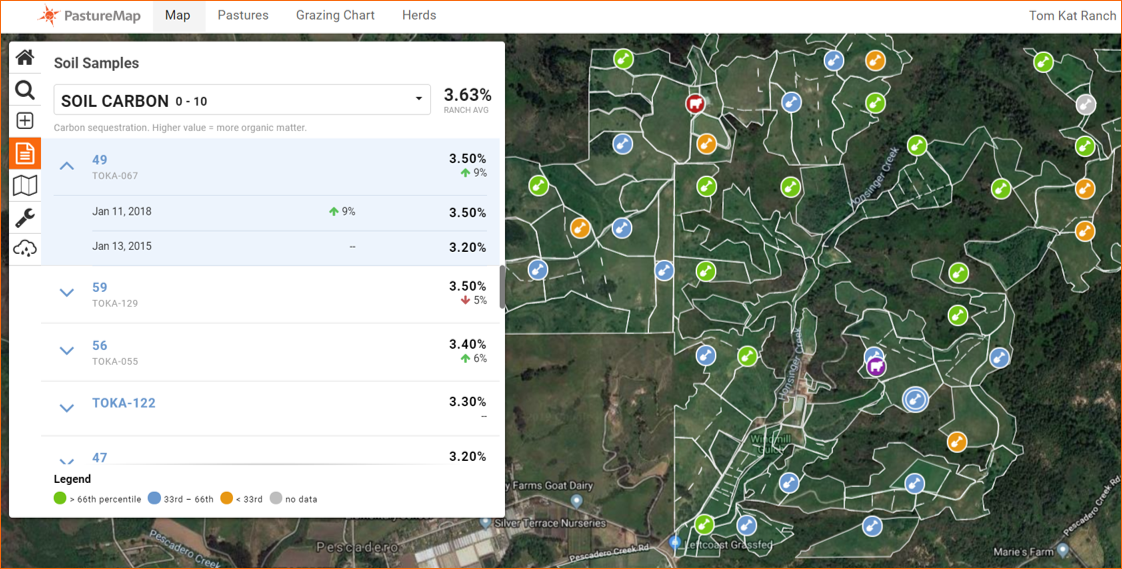PastureMap and Point Blue Conservation Science have launched the first mapping platform that combines soil health and grazing records for ranchers in California. Point Blue monitors soil health on 90 ranches across California. Their research has shown exciting soil health results from adaptive grazing since 2015. PastureMap's ranch management software enables ranchers to see soil health improvements side by side with their grazing management records. As ranchers use PastureMap in the field to plan cattle grazing, they can now see and adjust grazing management decisions that affect long term soil health.

PastureMap's soil health mapping features include the ability to track improvements or decreases in soil health over multiple years. It includes the most common soil health indicators: soil carbon, water holding capacity, and bulk density. Ranchers are able to upload soil health reports from either soil lab test results, or their own soil health data from field tests. Multiple years of soil health data on the same monitoring point can reflect changes with green or red arrows, indicating either soil health improvements or areas of concern.
Christine Su, CEO of PastureMap, said, “Combining soil health and grazing data creates powerful insights that help drive ranch management decisions. Many ranchers have multiple years of soil health data. Usually, these come back from the lab or in a report, and then sit in the rancher's files. Now they can upload that data to their PastureMap account, and compare their soil data to USDA soil maps as well as their own grazing patterns on each pasture.
So much of ranch management is visual. Now you can see: Which pastures have we done a good job in? Where is there room to improve? If I have poor soil organic matter in one area, is it because it's a sandy soil type, or is it my management? Am I improving water infiltration and bulk density over time? Or am I compacting my soil more in certain pastures and need a different grazing strategy? Seeing the data all in one place and how the land is responding to your management helps you plan your grazing strategies on on a multi-year time frame.”
Kelly Garbach, lead scientist of the partnership at Point Blue, said, “In the past, we shared soil data with collaborating ranchers in a written letter, with an in-person conversation to interpret patterns and findings. We are taking a cosmic leap forward to have interactive soil data on a digital map, tied in directly with grazing management records. I am thrilled to have discussions with ranchers about how their management practices influence soil health.”
Participants in the California pilot include Grounded Land and Livestock, Markegard Family Grass-Fed, 3 Bar Ranch, Richards Grassfed, TomKat Ranch, Cobblestone Ranch, Chico State University, and others across California's Sacramento and San Joaquin Valleys. This collaboration was made possible in part by the Elemental Excelerator's Just Innovation Prize, which supports equitable access to technology in California communities most affected by the effects of climate change. Grazing management for soil health is an important part of the solution to climate resilience. Regenerative grazing practices keep land covered with grass, both cooling the land surface, and improving water holding capacity in soil. Healthy grasslands provide both a carbon sink, and a water "sponge" for rainfall, which provides clean water and improves drought resilience. In wildfire-prone California, these benefits provided by ranchers managing local watersheds and rangelands are more important than ever.
Christine Su adds, “We are building the technology backbone for a transparent and traceable regenerative supply chain. Whether it’s for carbon markets, land and water conservation programs, or better food brands, sharing data in a simple and accessible format is a common need. Now ranchers have beautiful maps to share with anyone for transparent verification of the good they do for their local environment. This is the first step in helping ranchers get rewarded for their contributions in a regenerative economy.”
This project was supported by a Conservation Innovation Grant from the California NRCS and Elemental Excelerator. For more information on getting your soil data into PastureMap, contact christine@pasturemap.com or kgarbach@pointblue.org
